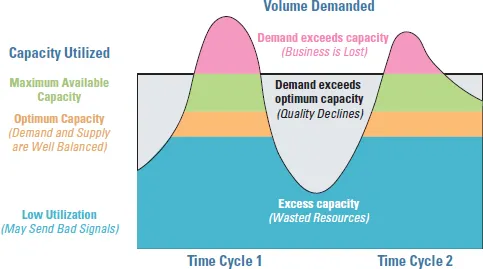![]()
VOLUME 7
Balancing Capacity and Demand of Service Operations
Balancing the supply and demand sides of a service industry is not easy, and whether a manager does it well or not makes all the difference.
W. Earl Sasser
Professor at Harvard Business School
They also serve who only stand and wait.
John Milton
English poet, 1608–1674
FLUCTUATIONS IN DEMAND THREATEN PROFITABILITY
Many services with limited capacity face wide swings in demand that can be caused by the change in seasons. This is a problem as service capacity usually cannot be kept aside for sale at a later date. The effective use of expensive productive capacity is one of the secrets of success in such businesses. The goal should be to utilize staff, labor, equipment and facilities as productively as possible. By working with managers in operations and human resources, service marketers may be able to develop strategies to bring demand and capacity into balance, in ways that create benefits for customers as well as to improve profitability for the business.
From Excess Demand to Excess Capacity
For fixed capacity firms, the problem is a familiar one. “It’s either feast or famine for us!” sighs the manager. “In peak periods, we’re disappointing prospective customers by turning them away. And in low periods when our facilities are idle, our employees are standing around looking bored, and we’re losing money.” In other words, demand and supply are not in balance.
At any given moment, a fixed-capacity service may face one of the four following conditions (Figure 1):
•Excess demand. The level of demand exceeds the maximum available capacity, resulting in some customers being denied service and loss of business.
•Demand exceeds optimum capacity. No one is turned away, but conditions are crowded and customers are likely to perceive a deterioration in service quality and may feel dissatisfied.
Figure 1: Implications of variations in demand relative to capacity.
•Demand and supply are well balanced at the level of optimum capacity. Staff and facilities are busy without being overworked, and customers receive good service without delays.
•Excess capacity. Demand is below optimum capacity and productive resources are under-utilized, resulting in low productivity. Low usage also poses a risk that customers may find the experience disappointing or have doubts about the viability of the service.
Sometimes optimum and maximum capacities are one and the same. At a live theater performance or sports event, a full-house looks grand and is exciting for the performers or players and audience. It creates a more satisfying experience for all. With most other services however, a customer might feel that they will get better service if the facility is not operating at full capacity. For instance, the quality of restaurant service often deteriorates when every table is occupied, because the staff is rushed and there is a greater likelihood of errors or delays. When traveling alone in an aircraft with high density seating, a passenger tends to feel more comfortable if the seat next to them is empty. When repair and maintenance shops are fully scheduled, delays may result if there is no slack in the system to allow for unexpected problems in completing particular jobs.
Building Blocks of Managing Capacity and Demand
There are two basic approaches to the problem of fluctuating demand. One is to adjust the level of capacity to meet variations in demand. This approach requires an understanding of what constitutes productive capacity and how it may be increased or decreased on an incremental basis. The second approach is to manage the level of demand. This requires a good understanding of demand patterns and drivers on a segment-by-segment basis, so that firms can use marketing strategies to smoothen out variations in demand. Most service firms use a mix of both approaches.1
Figure 2 shows the four building blocks that provide an integrative approach to balancing capacity and demand. The remainder of this volume is organized along these four building blocks.
Figure 2: Building blocks of effective capacity and demand management.
DEFINING PRODUCTIVE SERVICE CAPACITY
When referring to managing capacity, we implicitly mean productive capacity. This term refers to the resources or assets that a firm can use to create goods and services that are typically key cost components and therefore need to be managed carefully. In a service context, productive capacity can take several forms, including facilities, equipment, labor, and infrastructure.
1.Facilities critical to capacity management can relate to those designed to “hold” customers and those that hold goods. The former is used for people-processing services or mental-stimulus processing services. Examples include medical clinics, hotels, passenger aircrafts, and college classrooms. The primary capacity constraint is likely to be in terms of furnishings such as beds, rooms or seats. In some cases, local laws may limit the number of people allowed inside a facility for health or safety reasons. The latter relates to facilities designed for storing or processing goods that either belong to customers or are being offered to them for sale. Examples include pipelines, warehouses, parking lots, and railroad freight wagons.
2.Equipment used to process people, possessions, or information may encompass a large range of items and can be very situation-specific — diagnostic equipment, airport security detectors, toll gates, bank ATMs, and ‘seats’ in a call center are among many items whose absence in sufficient numbers for a given level of demand can bring service to a crawl, or even a complete stop.
3.Labor is a key element of productive capacity in all high-contact services and many low-contact ones. If staffing levels are not sufficient, customers might be kept waiting or service will become rushed. Professional services are especially dependent on highly skilled staff to create high value-added, information-based output. Abraham Lincoln captured it well when he remarked that “A lawyer’s time and expertise are his stocks in trade”.
4.Infrastructure capacity can also be critical. Many organizations are dependent on access to sufficient capacity in the public or private infrastructure to be able to deliver quality service to their customers. Capacity problems of this nature may include congested airways that lead to air traffic restrictions on flights, traffic jams on major highways, and power failures (or “brown outs” caused by reduced voltage).
Financial success in capacity-constrained businesses is, in large measure, a function of the management’s ability to use productive capacity — labor, equipment, facilities, and infrastructure — as efficiently and as profitably as possible. In practice, however, it is difficult to achieve this all the time. Not only do demand levels vary, often randomly, but the time and effort required to process each person or thing may vary widely at any point in the process. In general, processing times for people are more varied than for objects or things, reflecting the varying levels of preparedness (“I lost my credit card”), argumentative versus cooperative personalities (“If you will not give me a table with a view, I will have to ask for your supervisor”), and so forth. Furthermore, service tasks are not necessarily homogeneous. In both professional services and repair jobs, diagnosis and treatment times vary according to the nature of the customers’ problems.
MANAGING CAPACITY
Although service firms may encounter capacity limitations due to varying demand, there are a number of ways in which capacity can be adjusted to reduce the problem. Capacity can be stretched or shrunk, and the overall capacity can be adjusted to match demand.
Stretching Capacity Levels
Some capacity is elastic in its ability to absorb extra demand. Here, the actual level of capacity remains unchanged, and more people are being served with the same level of capacity. For example, normal capacity for a subway car may offer 40 seats and allow standing room for another 60 passengers with enough handrail and floor space for all. At rush hour however, up to 200 people could squeeze into a subway car, although under sardine-like conditions (Figure 3). Similarly, the capacity of service personnel can be stretched, and staff may be able to work at high levels of efficiency for short periods of time. However, staff would quickly tire and begin to provide poor service if they had to work that fast for a prolonged period of time.
Figure 3: Rush hour crowd stretches the capacity of train services.
Another way to stretch capacity is to utilize the facilities for longer periods. For example, some banks extend their opening hours during weekdays and even open on weekends. Universities may offer evening classes, and weekend and summer programs.
Lastly, the average amount of time customers (or their possessions) spend in process may be reduced. Sometimes, this is achieved by minimizing slack time. For example, a restaurant can buzz tables, seat arriving diners, present menus fast, and the bill can be presented promptly to a group of diners relaxing at the table after a meal.2 In other instances, it may be achieved by cutting back the level of service — by offering a simpler menu at busy times of the day.
Adjusting Capacity to Match Demand
Unlike stretching capacity, adjusting capacity involves tailoring the overall level of capacity to match variations in demand — a strategy also known as chasing demand. There are several actions that managers can take to adjust capacity as needed.3 These actions range from the easiest to implement to the more difficult:
•Schedule downtime during periods of low demand. To ensure 100% capacity during peak periods, maintenance, repair, and renovations should be conducted when demand is expected to be low. Employees should make use of these periods by taking leaves, etc.
•Cross-train employees. Even when the service delivery system operates at full capacity, some physical elements — and their attendant employees — may be under-utilized. If employees can be cross-trained to perform a variety of tasks, they can be shifted to bottleneck points whenever needed, thereby increasing total capacity. In supermarkets, for instance, the manager may call on stockers to operate cash registers when crowded. Likewise, during slow periods, the cashiers may be asked to help stock shelves.
•Use part-time employees. Many organizations hire extra workers during their peak periods, e.g., postal workers and retail store associates hired during festival seasons, extra staff hired in tax preparation service firms at the end of the financial year, and additional hotel employees hired during holiday periods and for major conventions.
•Invite customers to perform self-service. If the number of employees is limited, capacity can be increased by involving customers in the co-production of certain tasks. One way to do this is by adding self-service technologies such as electronic kiosks at the airport for airline ticketing and check-in, or automated check-out stations at supermarkets.
•Ask customers to share. Capacity can be stretched by asking customers to share a unit of capacity normally meant for one ind...



